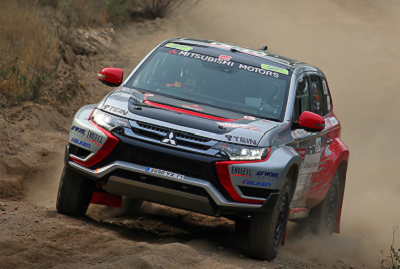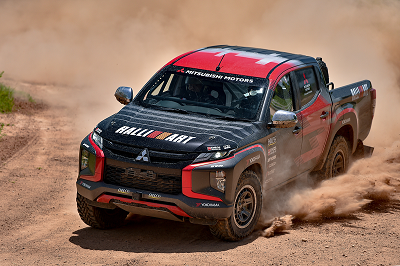The potential of our electric powered vehicles (EVs/PHEVs) proven in rally competitions

Public Relation Dept.
Hiroshi Masuoka
First Japanese rally driver to claim two consecutive victories overall championships at the Dakar Rally

Advanced Engineering Development Dept.
Yasuo Tanaka
Engineer who was mainly responsible for WRC, PPIHC and other sprint rallies

Ralliart Business Promotion Office
Yoji Ohtani
In charge of motor sports promotion at that time
Mitsubishi Motors withdrew from the WRC after the 2005 season and from the Dakar Rally after 2009, then returned to the world of competitive auto racing in 2012. We competed with EVs for three consecutive years in a race with over a century-long history in the US called the Pikes Peak International Hill Climb (abbreviated as "Pikes Peak" below).
"Our objective there was very different from the WRC and Dakar Rally," says Yoji Ohtani of the Ralliart Business Promotion Office.
"In the WRC and Dakar Rally, we operated in a cycle of doing lots of development on the front lines of rallies, then putting the technology and expertise gained there into cars for the market and reflecting feedback obtained from the market in development for subsequent competition cars. However, our objective in Pikes Peak was to demonstrate our technologies of the mass-produced EV that we were first in the world to release in 2009."
Pikes Peak is a race to be the first one to the summit on a mountain course. At the time, EVs were seen as having no power and being slow, so we wanted to dispel that image while also verifying the performance of our EV technologies.
Two-time Dakar Rally winner Hiroshi Masuoka served as both team manager and driver. He competed for the championship in the Electric Division the first year, taking second place. Beccy Gordon also drivied a car with the exact same specs as the model available on the North American market, finishing sixth. Masuoka reflects on feeling the potential of EVs.
"It was my first time driving the i-MiEV Evolution*1 on a mountain course, and it was really the most incredible feeling. The distinctive instantaneous power and response unique to the electric motor were excellent. I realized the potential of EVs. The finish line at Pikes Peak reaches an elevation of 4,300 meters, so the air there is around 40% thinner than at sea level. This lowers the output of cars with internal combustion engines, but it has no effect whatsoever on an electric motor. As a result, I got to fully savor the powerful, quiet ride of an EV."

i-MiEV Evolution(2012 PPIHC)
After that, we evolved our machines and in our third year of the competition we swept the top two places in the Electric Modified Division. Yasuo Tanaka of the Advanced Engineering Development Department who participated as an engineer talks about the strategy at the time for those races.
"The first year we used our mass production battery as-is and learned about its potential. The second year, we raised the output of the mass production unit to its limit, and in the third year we tried out a motor and other thing we were developing for the future. We also introduced the S-AWC (Super-All Wheel Control) system, which was able to control the inner and outer wheels and dramatically improve cornering.
Masuoka who took second place says that competing in Pikes Peak played a very significant role in technological development of electric powered vehicles such as EVs and PHEVs at Mitsubishi Motors.
"We were able to prove that the accelerative force particular to EVs that can accelerate to 100 km/h in only two seconds, combined with the stability of four-wheel control that was utilized in every one of the 156 turns on the course, can be a formidable weapon in rallies. During the process of competing in Pikes Peak for three years and developing cutting-edge EV racing machines, we were able to acquire several highly advanced technologies."


MiEV Evolution(2014 PPIHC)
- 1: Dedicated racing model used to compete in Pikes Peak in 2012, equipped with the electric motor, batteries, and other main components of the commercially available version of the i-MiEV.
Dispelling the Image that PHEVs are vulnerable to water
To also demonstrate the potential of our Outlander PHEV, we entered the Asian Cross Country Rally ("AXCR") in 2013. The scene was Thailand. Starting in the beach resort of Pattaya, we competed in a grueling course that tests a vehicle's durability and road handling through many different types of terrain, including mountainous roads, dense forests, mud surfaces, and river crossings, covering approximately 2,000 kilometers over six days until finishing in the city of Pakse in southern Laos. Although there were 20 vehicles competing in the four-wheeled category, the Outlander PHEV was the only electric powered vehicle among them. As it started up in EV-mode, the quietness of the Outlander PHEV shattered spectators' conventional assumptions of loud, roaring rally vehicles at the ceremonial start of the race in Pattaya. It was an extremely harsh course for the Outlander PHEV due to its relatively low ground clearance compared to pickup trucks and cross-country 4WD vehicles, but it still successfully completed the race in 17th place. There were no problems at all with the PHEV system or Twin Motor 4WD/S-AWC, thus proving their reliability. Speeding along unfettered even while partially submerged in mud, the Outlander PHEV dispelled the Image that EVs and PHEVs are vulnerable to water.
We entered and completed the AXCR for three straight years. The Outlander PHEV also competed in the Australasian Safari 2014 cross-country rally from Perth to Kalbarri in western Australia. It completed this tortuous course with a total distance of approximately 3,529 kilometers in 57 hours, 49 minutes and 14 seconds, finishing in 19th position overall and winning its class. In 2015 we competed in the Baja Portalegre 500 ("Baja") held in Portalegre, a municipality in eastern Portugal, completing an off-road course spanning a total distance of approximately 700 kilometers.
Competing in these rallies, we were able to accomplish our original goals of demonstrations for the sake of rolling out an electric powered vehicle to the market and boosting reliability, but another major benefit of these efforts came in the form of human resources development.
For a long while, Mitsubishi Motors' days of competing in rallies were fading further into the past. For Tanaka, who had also himself competed in the WRC, this was posing a major problem in passing on technical know-how to younger employees.
"In Pikes Peak, AXCR, and Baja, we generally had our young engineers who work on production model cars serve as the mechanics. In the world of races where the work must be done by morning, they also have to cover things unrelated to their own areas. I think they grew tremendously by learning the importance of being able to work as a team."
As manager of the team Masuoka also says, "Rallies are also a place for refining technology."
"We can learn the spirit of craftsmanship by getting behind the wheel and seeing for ourselves the technology we developed. I really felt like we should leverage the valuable experience of rallies in making cars that customers can ride with peace of mind."

Outlander PHEV Rally Car(2015 AXCR)

Outlander PHEV Rally Car(2015 Baja)
A new legend begins in Thailand
In 2022, Team Mitsubishi Ralliart*2 competed in the AXCR with the Triton one-ton pickup truck, backed by our technical support. In this grueling off-road race primarily through mountainous roads and dense forests in the hot, humid ASEAN climate, the objective was to further refine our strengths in producing tough bodies and chassis, and delivering superior steering stability and handling on rough, unpaved roads. Ohtani gets excited about how this is different from competing with the PHEV, in which the objective was to test things out.
"This time, the objective is to refine even more advanced technology, achieve results in a challenging race, then reflect the technologies obtained from it in cars for the market. In the rally competition, we expose the vehicle to the same workload a typical customer would put it through over several months, years, or tens of thousands of miles, all in a short period of time in one race. I hope we can take the strengths and weaknesses that we learn about over the short few days of this race and reflect it abundantly in development for our future products."
As general manager, Masuoka also spares no effort in the preparation.
"We competed for many years in races such as the WRC and Dakar Rally, reached the pinnacle of each, and delivered the distinctively Mitsubishi Motors ride quality to comfortably enjoy driving through any kind of weather, on any kind of road surface. This time, competing in the AXCR in a technical support role will lead to better pickup truck and cross-country SUV products, which are our main lines of products in ASEAN."
The competition model of the Triton has a double cab base according to Thailand specifications, with significantly improved handling and maneuverability on rough and unpaved surfaces. The new legend of Mitsubishi Motors and Ralliart is set to begin.

Triton Rally Car(2022 AXCR)
- 2: Mitsubishi Motors' heritage brand which has developed our driving capabilities and technologies in the grueling fields of WRC and the Dakar Rally.